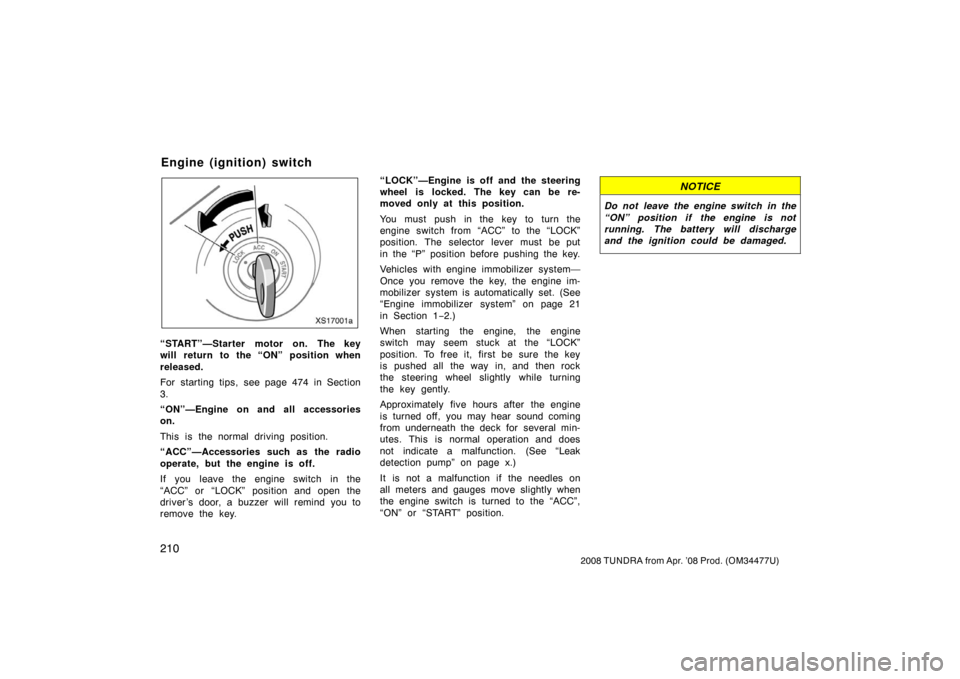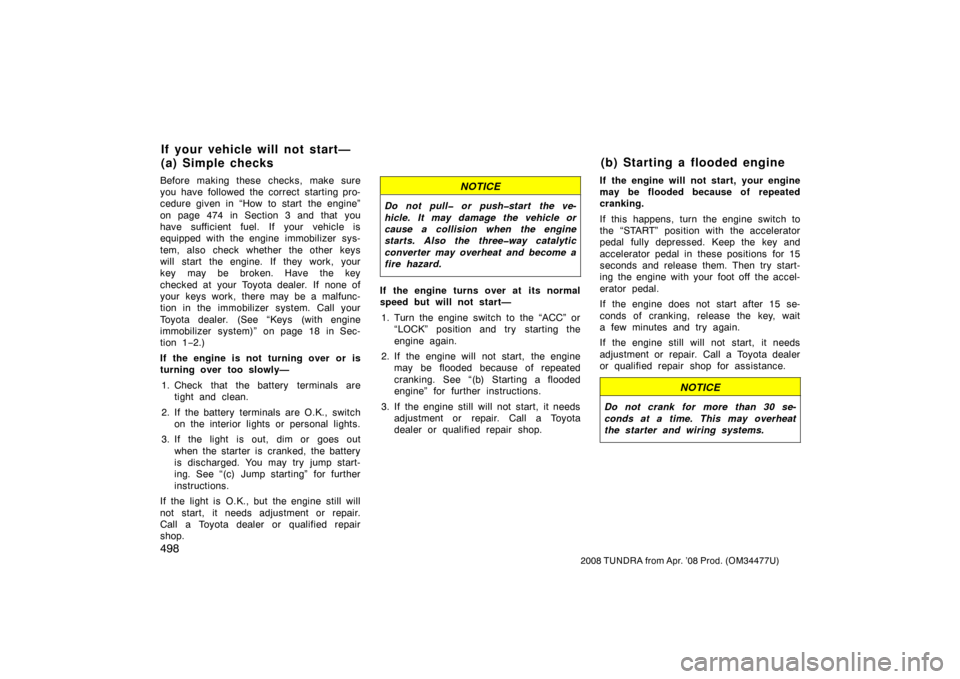Page 220 of 621

210
2008 TUNDRA from Apr. ’08 Prod. (OM 34477U)
XS17001a
“START”—Starter motor on. The key
will return to the “ON” position when
released.
For starting tips, see page 474 in Section
3.
“ON”—Engine on and all accessories
on.
This is the normal driving position.
“ACC”—Accessories such as the radio
operate, but the engine is off.
If you leave the engine switch in the
“ACC” or “LOCK” position and open the
driver ’s door, a buzzer will remind you to
remove the key. “LOCK”—Engine is off and the steering
wheel is locked. The key can be re-
moved only at this position.
You must push in the key to turn the
engine switch from “ACC” to the “LOCK”
position. The selector lever must be put
in the “P” position before pushing the key.
Vehicles with engine immobilizer system—
Once you remove the key, the engine im-
mobilizer system is automatically set. (See
“Engine immobilizer system” on page 21
in Section 1−
2.)
When starting the engine, the engine
switch may seem stuck at the “LOCK”
position. To free it, first be sure the key
is pushed all the way in, and then rock
the steering wheel slightly while turning
the key gently.
Approximately five hours after the engine
is turned off, you may hear sound coming
from underneath the deck for several min-
utes. This is normal operation and does
not indicate a malfunction. (See “Leak
detection pump” on page x.)
It is not a malfunction if the needles on
all meters and gauges move slightly when
the engine switch is turned to the “ACC”,
“ON” or “START” position.
NOTICE
Do not leave the engine switch in the
“ON” position if the engine is not
running. The battery will discharge
and the ignition could be damaged.
Engine (ignition) switch
Page 490 of 621

480
2008 TUNDRA from Apr. ’08 Prod. (OM 34477U)
Check the condition of the battery and
cables.
Cold temperatures reduce the capacity of
any battery, so it must be in top shape
to provide enough power for winter start-
ing. Section 7−3 tells you how to visually
inspect the battery. Your Toyota dealer
and most service stations will be pleased
to check the level of charge.
Make sure the engine oil viscosity is
suitable for the cold weather.
See page 549 in Section 7 −2 for recom-
mended viscosity. Leaving a heavy sum-
mer oil in your vehicle during winter
months may cause harder starting. If you
are not sure about which oil to use, call
your Toyota dealer—they will be pleased
to help.
Keep the door locks from freezing.
Squirt lock de −icer or glycerine into the
locks to keep them from freezing. To open
a frozen lock, try heating the key before
inserting it.
Use a washer fluid containing an anti�
freeze solution.
This product is available at your Toyota
dealer and most auto parts stores. Follow
the manufacturer ’s directions for how
much to mix with water.NOTICE
Do not use engine antifreeze or any
other substitute because it may dam-
age your vehicle’s paint.
Do not use your parking brake when
there is a possibility it could freeze.
When parking, put the transmission into
“P” and block the front wheels. Do not
use the parking brake, or snow or water
accumulated in and around the parking
brake mechanism may freeze, making it
hard to release.
Keep ice and snow from accumulating
under the fenders.
Ice and snow built up under your fenders
can make steering difficult. During bad
winter driving, stop and check under the
fenders occasionally.
Depending on where you are driving,
we recommend you carry some emer-
gency equipment.
Some of the things you might put in the
vehicle are tire chains, window scraper,
bag of sand or salt, flares, small shovel,
jumper cables, etc.XS30007
Your vehicle is not designed to be
dinghy towed (with four wheels on the
ground) behind a motorhome.
NOTICE
Do not tow your vehicle with four
wheels on the ground. This may
cause serious damage to your vehicle.
Dinghy towing
Page 508 of 621

498
2008 TUNDRA from Apr. ’08 Prod. (OM 34477U)
Before making these checks, make sure
you have followed the correct starting pro-
cedure given in “How to start the engine”
on page 474 in Section 3 and that you
have sufficient fuel. If your vehicle is
equipped with the engine immobilizer sys-
tem, also check whether the other keys
will start the engine. If they work, your
key may be broken. Have the key
checked at your Toyota dealer. If none of
your keys work, there may be a malfunc-
tion in the immobilizer system. Call your
Toyota dealer. (See “Keys (with engine
immobilizer system)” on page 18 in Sec-
tion 1−2.)
If the engine is not turning over or is
turning over too slowly— 1. Check that the battery terminals are tight and clean.
2. If the battery terminals are O.K., switch on the interior lights or personal lights.
3. If the light is out, dim or goes out when the starter is cranked, the battery
is discharged. You may try jump start-
ing. See “(c) Jump starting” for further
instructions.
If the light is O.K., but the engine still will
not start, it needs adjustment or repair.
Call a Toyota dealer or qualified repair
shop.NOTICE
Do not pull� or push�start the ve-
hicle. It may damage the vehicle or
cause a collision when the engine
starts. Also the three�way catalytic
converter may overheat and become a
fire hazard.
If the engine turns over at its normal
speed but will not start—
1. Turn the engine switch to the “ACC” or “LOCK” position and try starting the
engine again.
2. If the engine will not start, the engine may be flooded because of repeated
cranking. See “(b) Starting a flooded
engine” for further instructions.
3. If the engine still will not start, it needs adjustment or repair. Call a Toyota
dealer or qualified repair shop. If the engine will not start, your engine
may be flooded because of repeated
cranking.
If this happens, turn the engine switch to
the “START” position with the accelerator
pedal fully depressed. Keep the key and
accelerator pedal in these positions for 15
seconds and release them. Then try start-
ing the engine with your foot off the accel-
erator pedal.
If the engine does not start after 15 se-
conds of cranking, release the key, wait
a few minutes and try again.
If the engine still will not start, it needs
adjustment or repair. Call a Toyota dealer
or qualified repair shop for assistance.
NOTICE
Do not crank for more than 30 se-
conds at a time. This may overheat
the starter and wiring systems.
If your vehicle will not start—
(a) Simple checks
(b) Starting a flooded engine
Page 601 of 621

591
2008 TUNDRA from Apr. ’08 Prod. (OM 34477U)
COOLING SYSTEM
Total capacity, L (qt., Imp. qt.):
4.0 L V6 (1GR −FE) engine
9.6 (10.1, 8.4)
4.7 L V8 (2UZ −FE) engine
9.7 (10.3, 8.5)
5.7 L V8 (3UR −FE) engine
With towing package
13.0 (13.7, 11.4)
Without towing package 12.1 (12.8, 10.6)
Coolant type: “Toyota Super Long Life Coolant” is
used in your Toyota vehicle at factory
fill. In order to avoid technical problems,
only use “Toyota Super Long Life
Coolant” or similar high quality ethylene
glycol based non −silicate, non −amine,
non− nitrite, and non− borate coolant with
long− life hybrid organic acid technology.
(Coolant with long −life hybrid organic
acid technology is a combination of low
phosphates and organic acids.)
Do not use plain water alone.
Please contact your Toyota dealer for
further details. BATTERY
Open voltage
∗ at 20
°C (68 °F):
12.6—12.8 V Fully charged
12.2—12.4 V Half charged
11.8—12.0 V Discharged
∗: Voltage that is checked 20 minutes after the key is removed with all the
lights turned off
Charging rates: 5 A max. AUTOMATIC TRANSMISSION
Fluid capacity, L (qt., Imp. qt.):
4.0 L V6 (1GR −FE) engine
10.5 (11.1, 9.2)
∗
4.7 L V8 (2UZ −FE) engine
With towing package 11.1 (11.7, 9.8)
∗
Without towing package10.5 (11.1, 9.2)∗
5.7 L V8 (3UR−FE) engine
With towing package 11.7 (12.4, 10.3)
∗
Without towing package 11.1 (11.7, 9.8)∗
∗
: The fluid capacity is the quantity of ref- erence. If replacement is necessary,
contact your Toyota dealer.
Fluid type: Toyota Genuine ATF WS
Change automatic transmission fluid only
as necessary.